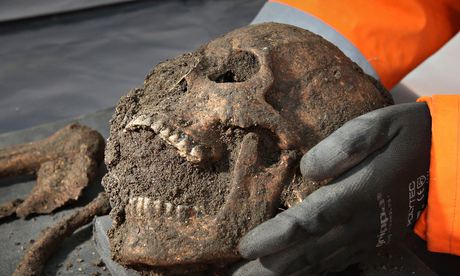
Black death researchers extracted plague DNA from 14th century skulls discovered in east London. Photograph: Philip Toscano/PA
Archaeologists and forensic scientists who have examined 25 skeletons unearthed in the Clerkenwell region of London a yr ago believe they have uncovered the reality about the nature of the Black Death that ravaged Britain and Europe in the mid-14th century.
Evaluation of the bodies and of wills registered in London at the time has cast doubt on “facts” that each schoolchild has discovered for decades: that the epidemic was induced by a extremely contagious strain spread by the fleas on rats.
Now evidence taken from the human stays identified in Charterhouse Square, to the north of the City of London, in the course of excavations carried out as element of the building of the Crossrail train line, have suggested a different lead to: only an airborne infection could have spread so fast and killed so speedily.
The Black Death arrived in Britain from central Asia in the autumn of 1348 and by late spring the following yr it had killed 6 out of every single 10 folks in London. Such a price of destruction would kill 5 million now. By extracting the DNA of the ailment bacterium, Yersinia pestis, from the greatest teeth in some of the skulls retrieved from the square, the scientists had been able to examine the strain of bubonic plague preserved there with that which was not too long ago responsible for killing 60 folks in Madagascar. To their shock, the 14th-century strain, the cause of the most lethal catastrophe in recorded history, was no more virulent than today’s illness. The DNA codes had been an virtually excellent match.
In accordance to scientists working at Public Overall health England in Porton Down, for any plague to spread at this kind of a speed it need to have got into the lungs of victims who have been malnourished and then been spread by coughs and sneezes. It was as a result a pneumonic plague rather than a bubonic plague. Infection was spread human to human, rather than by rat fleas that bit a sick individual and then bit one more victim. “As an explanation [rat fleas] for the Black Death in its personal proper, it basically isn’t good enough. It cannot spread fast adequate from one home to the next to cause the enormous variety of situations that we noticed for the duration of the Black Death epidemics,” explained Dr Tim Brooks from Porton Down, who will put his theory in a Channel 4 documentary, Secret History: The Return of the Black Death, next Sunday.
To support his argument, Brooks has looked at what occurred in Suffolk in 1906 when plague killed a loved ones and then spread to a neighbour who had come to assist. The culprit was pneumonic plague, which had settled in the lungs of the victims and was spread by way of infected breath.
The skeletons at Charterhouse Square reveal that the population of London was also in generally poor wellness when the illness struck. Crossrail’s archaeology contractor, Don Walker, and Jelena Bekvalacs of the Museum of London found evidence of rickets, anaemia, negative teeth and childhood malnutrition.
In help of the situation that this was a quickly-acting, direct contagion, archaeologist Dr Barney Sloane found that in the medieval City of London all wills had to be registered at the Court of Hustings. These led him to believe that 60% of Londoners were wiped out.
Antibiotics can these days avoid the disease from turning out to be pneumonic. In the spring of 1349, the death fee did not ease right up until Pentecost on 31 May possibly.
Black death was not spread by rat fleas, say researchers
Hiç yorum yok:
Yorum Gönder